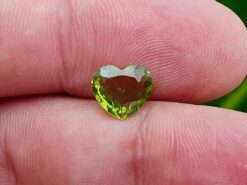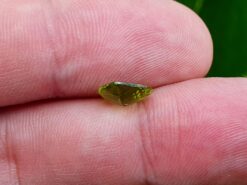Peridot

Peridot stone is the birthstone of August, a famous gemstone used in jewelry as earrings, rings, necklaces, pendants, bracelets. Loved for its vibrant green hue, the peridot stone has enchanted civilizations throughout history. From ancient Egypt to modern day collectors, this gem never ceases to inspire awe for its unique color, fascinating origins, and reputed mystical qualities.
Buy natural peridot in our shop
Peridot stone is gem-quality olivine. It is a silicate mineral with the formula of (Mg, Fe)2SiO4. A magnesium-rich variety of olivine (forsterite), it is often used as peridot gemstone jewelry in earrings, rings, necklaces, pendants, and bracelets. Its natural color range and relative durability have made it a staple in jewelry traditions around the world.
Appearance
Peridot is one of the few gemstones that occur in only one color: an olive-green. The intensity and tint of the green, however, depends on the percentage of iron in the crystal structure. This variation in iron content can give each peridot stone a slightly different shade, from a vivid, bright green to a subtle, muted hue.
The color can range from yellowish-green to olive, and even a brownish-green. In rare cases, the gemstone appears in a medium-dark toned, visually pure green with no secondary yellow or brown overtones. In any shade, the warmth of the peridot stone is universally appreciated by gem enthusiasts.
Geology
Olivine in general is a very abundant mineral, but gem-quality forsterite (the magnesium-rich variety) is rather rare. This is due to the mineral’s chemical instability on the Earth’s surface. We usually find olivine as small grains and in a heavily weathered state, which is unsuitable for decorative use. Larger crystals of forsterite, the variety most often cut into peridot stone, are uncommon. Because of this, olivine—when suitable for cutting—is considered a semi-precious gem. Yet, when you do find a fine, sizable crystal, the color and clarity can be spectacular.
Geologically, peridot stone forms deep within the Earth’s mantle and is brought to the surface by volcanic activity. This slow process of creation means that well-formed crystals can be a testament to Earth’s geological and dynamic past, reflecting both the planet’s fiery interior and the beauty it creates above ground.
Peridot, from Mondulkiri, Cambodia
History
Peridot has a very long written history. Ancient papyri record the mining of these stones as early as 1500 BC. The main source in the ancient world was Topazo Island (now Zabargad or St. John’s Island) in the Egyptian Red Sea. Because of this early discovery, peridot stone was highly prized by Egyptian royalty.
In Ancient times, stones were also used for carved talismans. The island inhabitants were once forced to collect the gems for the Pharaoh’s treasury. Another legend mentions that jealous watchers guarded the island, with orders to execute any trespassers. It is said that miners searched for the gem both day and night, with peridot stone believed to glow under moonlight, guiding them toward its location.
The largest cut peridot is a 310 carat (62 g) specimen housed in the Smithsonian Museum in Washington, D.C. This grand example represents the captivating allure that a large peridot stone can possess, drawing the eyes of gem enthusiasts worldwide.
Gemological properties
- Mineral: Olivine
- Chemistry: (MgFe)2SiO4
- Color: Yellowish green
- Refractive index: 1.65 to 1.69
- Birefringence: 0.035 to 0.038
- Specific gravity: 3.34
- Mohs hardness: 6.5 to 7
Peridot under microscope
Peridot birthstone
Peridot is the birthstone of August. Its association with late summer has made it a popular gift for anyone born in that month. Many also believe that peridot stone aligns nicely with late summer’s warm glow and vibrant energy.
Peridot meaning and healing properties benefits
The following section is pseudo scientific and based on cultural beliefs.
The gemstone is said to help a person follow their passion, stay true to their deepest desires, and remain connected to their heart’s calling. For those seeking personal evolution, peridot stone is believed to encourage moving forward and releasing lingering negativity from the past.
This gem is known to increase willpower and heighten awareness of your thoughts, aligning them with purposeful action. Since thoughts often create our reality, many wearers use peridot stone to foster responsibility, positivity, and personal growth. It is also connected to the heart chakra, highlighting themes of compassion and emotional openness.
In various traditions, peridot stone is praised for its supportive energy, especially for those who struggle with receiving love or abundance. It can serve as a reminder that gratitude and acceptance pave the way for greater prosperity in relationships and opportunities. Additionally, it is rumored to promote fame, strength, and self-confidence—qualities beneficial for those seeking a public role.
A necklace featuring this bright stone is believed to encourage optimism. In folklore, peridot stone was said to dispel jealousy and envy. It was also rumored to ward off nightmares when placed near the bed at night, though many caution not to sleep with the gem directly on the body to avoid potential discomfort.
FAQ
What does peridot symbolize?
The August birthstone symbolizes strength. It is sometimes called the “evening emerald” for its light green color. It was once believed that the green peridot crystals found in volcanic ashes were the tears of the volcano goddess, Pele.
Is peridot worth anything?
Peridot ranges in price from about $30 to $80 US per carat, for well cut gems in the 1 or 2 carat size, up to as much as $400 to $450 per carat for large fine gems of top color.
Who can wear peridot?
The stone is regarded as a gemstone for people born in the month of August and also those belonging to the zodiac sign of Libra. Many people also offer the stone as gifts for 3rd and 16th wedding anniversaries.
Is peridot a lucky stone?
Given its color and energetic properties, the gem is often considered a stone for opening the heart, as well as for attracting abundance, family harmony, and good luck. Found in abundance, peridot is quite affordable compared to many other gemstones that share similar energetic properties.
Are peridots rare?
The stone is a fairly common mineral found in several parts of the world, but large, top-quality gems are indeed rare.
What powers does peridot have?
Known as the stone of compassion, the gemstone is believed to bring good health, restful sleep, and peace to relationships by balancing emotions and the mind. This friendly bright green stone also has the uncanny ability to inspire eloquence and creativity; it brings delight and good cheer.
Can you wear peridot jewelry every day?
The hardness and toughness of the stone make it relatively safe to wear every day. However, it is best suited for pendants and earrings since rings can be more prone to accidental knocks. If worn in a ring, take extra care to protect the gem from hard impacts.
How strong is peridot?
The gemstone is relatively soft, rating a 6.5 to 7 on the Mohs hardness scale—slightly softer than some other stones. It should be spared rugged wearing if mounted in rings. The stone is also sensitive to rapid temperature changes.
How can you tell if a peridot is real?
Due to its molecular structure, almost every genuine peridot stone has inclusions or cracks. If it appears too perfect, it might be a glass imitation. Brown or yellow inclusions and small chips are common indicators of a real peridot.
What chakra is peridot?
This crystal carries a beautiful green energy that activates the heart chakra, located near the center of the breastbone. It regulates our interaction with the external world and controls what we embrace and what we resist, giving us the ability to remain true to ourselves in the midst of change.
Natural peridot for sale in our gem shop
We make custom-made peridot stone jewelry such as engagement rings, necklaces, stud earrings, bracelets, and pendants. Please contact us for a quote.


